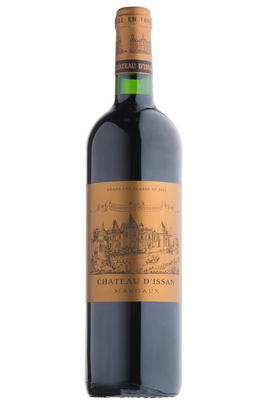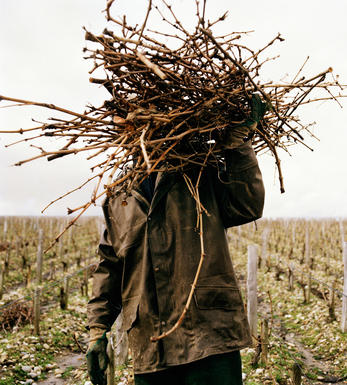
2021 Château d'Issan, Margaux, Bordeaux

Critics reviews
According to Emmanuel Cruse, the 2021 d'Issan is the second vintage to utilize all five permitted grape varieties, picked from September 27 to October 9 and matured in 50% new oak. Quite intense on the nose, it offers layers of raspberry, wild strawberry, iodine and incense aromas. The palate is structured on the entry with a judicious touch of white pepper and clove, building nicely without fully letting go. Linear and detailed on the finish, this is a fine Margaux that should give 20 years of drinking pleasure.
Neal Martin, vinous.com, (May 2022)
Rich aromatics, fresh acidities, careful extraction showcasing black tea and saffron spice notes, balanced and elegant, building in momentum through the palate. Skilful winemaking with plenty of grip. Has austerity through the mid palate, but no dip, and the tannins elongate towards the finish, giving salinity and a moutwatering kick. You can clearly imagine this ageing well, in the slightly sombre but classic style of 2002 or 2006. 50% new oak. Second year with all five of the major black grape varieties of the Médoc, and the Malbec and Petit Verdot make their presence felt.
Drink 2026 - 2042
Jane Anson, janeanson.com (May 2022)
The 2021 D'Issan is performing well, exhibiting aromas of rich berries, licorice, violets, sweet soil tones and pipe tobacco. Medium to full-bodied, layered and lively, with powdery tannins and a saline finish, it will flesh out with élevage to deliver a supple, perfumed D'Issan that will offer a broad drinking window. It's a blend of 65% Cabernet Sauvignon, 30% Merlot and the rest Cabernet Franc, Malbec and Petit Verdot.
William Kelley, Wine Advocate (Apr 2022)
Discreet but fresh with a faint floral nuance. Medium-bodied with a certain density of tannin but delicate and poised. Margaux elegance if slightly reserved.
Drink 2028 – 2040
James Lawther, jancisrobinson.com (May 2022)
About this WINE

Chateau d'Issan
Ch. d`Issan is a Third Growth Margaux property that produces about 100,000 bottles each year. Its richly aromatic and silky-textured Clarets are often amongst the best of the appellation.
The estate’s history dates back to the 1152 when the wine was officially served at the wedding of Eleanor of Aquitaine to King Henry II, the beginning of a special relationship between Bordeaux and England. The d’Essenault family owned the estate over five generations and rebuilt the existing château at the end of the 16th century. Surrounded by a moat, it is one of the oldest châteaux in the region and is frequently described as the most romantic in the Médoc.
In 1945 the Cruse family – already established in the Médoc for more than 150 years – purchased the property. Today Emmanuel Cruse runs the estate with the Lorenzetti family (owners of Chx Pédesclaux and Ladouys). They own 44 hectares in Margaux, planted with 62 percent Cabernet Sauvignon and 38 percent Merlot. The wine spends between 16 and 18 months in oak (around 50 percent new).

Margaux
If Pauillac can be seen as the bastion of ‘traditional’ Red Bordeaux, then Margaux represents its other facet in producing wines that are among Bordeaux’s most sensual and alluring. It is the largest commune in the Médoc, encompassing the communes of Cantenac, Soussans, Arsac and Labaude, in addition to Margaux itself. Located in the centre of the Haut-Médoc, Margaux is the closest of the important communes to the city of Bordeaux.
The soils in Margaux are the lightest and most gravelly of the Médoc, with some also containing a high percentage of sand. Vineyards located in Cantenac and Margaux make up the core of the appelation with the best vineyard sites being located on well-drained slopes, whose lighter soils give Margaux its deft touch and silky perfumes. Further away from the water, there is a greater clay content and the wines are less dramatically perfumed.
Margaux is the most diffuse of all the Médoc appelations with a reputation for scaling the heights with irreproachable wines such as Ch. Margaux and Ch. Palmer, but also plumbing the depths, with too many other châteaux not fulfilling their potential. There has been an upward shift in recent years, but the appellation cannot yet boast the reliability of St Julien. However, the finest Margaux are exquisitely perfumed and models of refinement and subtlety which have few parallels in Bordeaux.
Recommended Châteaux: Ch. Margaux, Ch. Palmer, Ch. Brane-Cantenac, Ch. Rauzan-Ségla , Ch. Dufort-Vivens, Ch. Ferrière, Ch. du Tertre, Ch. Giscours, Ch. d'Angludet.

Cabernet Sauvignon Blend
Cabernet Sauvignon lends itself particularly well in blends with Merlot. This is actually the archetypal Bordeaux blend, though in different proportions in the sub-regions and sometimes topped up with Cabernet Franc, Malbec, and Petit Verdot.
In the Médoc and Graves the percentage of Cabernet Sauvignon in the blend can range from 95% (Mouton-Rothschild) to as low as 40%. It is particularly suited to the dry, warm, free- draining, gravel-rich soils and is responsible for the redolent cassis characteristics as well as the depth of colour, tannic structure and pronounced acidity of Médoc wines. However 100% Cabernet Sauvignon wines can be slightly hollow-tasting in the middle palate and Merlot with its generous, fleshy fruit flavours acts as a perfect foil by filling in this cavity.
In St-Emilion and Pomerol, the blends are Merlot dominated as Cabernet Sauvignon can struggle to ripen there - when it is included, it adds structure and body to the wine. Sassicaia is the most famous Bordeaux blend in Italy and has spawned many imitations, whereby the blend is now firmly established in the New World and particularly in California and Australia.


Buying options
Add to wishlist
Description
Cabernet Sauvignon 65%, Merlot 30%, Cabernet Franc 2%, Malbec 2%, Petit Verdot 1%
Having acquired new plots from neighbouring Pontac-Lynch, Emmanuel Cruse now has a broader palette with which to work. Cabernet Franc, Petit Verdot and, unusually, Malbec are now in play. He considers the latter very interesting in the context of climate change. Issan is sometimes a wine that seems on full throttle, but this is nicely engaged; the suggestion is that the new grape varieties have added some control. This is still juicy but with some aromatic complexity and cool, spicy notes. The palate is well structured and the wine progresses, rather than flows, to a well composed, refreshing finish. Drink 2026-2042.
Our score: 17.5/20
Berry Bros. & Rudd, April 2022
wine at a glance
Delivery and quality guarantee